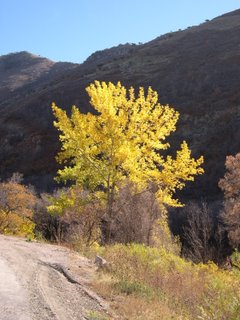
Fall Colors in Emigration Canyon
Greetings All,
Well, for it being the end of October, the weather continues to be better than expected. Cool, dry weather has made for some outstanding riding conditions. There have been a few early (cold) starts to the day, but for the most part, with the right layers, riding has been fantastic.
Speaking of layers, I recently purchased a Patagonia merino wool base layer. It was expensive, but so far seems to be well worth the cost. It is light, warm, soft, and performs better than any base layer I have used so far. It keeps me warm, and I don’t overheat after the temperature rises later in the day.
This week I am bringing you a different facet of cycling; long distance marathon cycling, specifically, randonneuring, or brevet riding. I have searched the ‘net far and wide for information, and most of the data below is excerpted from the Alberta and British Columbia Randoneuring sites.

Looking west, down Emigration Canyon
What is Randonneuring?
Randonneuring is ultra-distance, endurance cycling. Riders challenge their physical and mental abilities by riding set distances in a prescribed time frame. The most common type of Randonneuring event is a brevet, referring to the certificate (brevet) the rider receives upon successful completion of the event. Typical brevet distances are 200km, 300km, 400km, 600km and 1000km in distance. Longer events known as randonnées can range from 1200km to 3000km in distance. The most famous of these and longest running cycling race/event in history, is the 1200km Paris-Brest-Paris (PBP) which first ran on September 6th ,1891. In 2003, there were over 4000 riders in PBP from 28 countries. Fast times are not the primary objective for all Randonneurs. Finishing an event within the time limit is the most important goal of Randonneuring. Riders compete against the clock, themselves, terrain and environment (especially the weather!). Being first is never the paramount goal and participants certainly pair up or group together during the events. However, it is not unheard of to see riders pushing themselves and each other to see who can clock the fastest time or be pushed to a personal best for an event. Provided one finishes within the time limit for the event, Randonneuring permits cyclists to "do the ride at the pace of their choosing". Whether you are an avid cycling tourist looking for the next challenge, an Ironman-Triathlete or competitive road racer looking for options to enhance your training, or you are just a little bit eccentric and obsessive about cycling, Randonneuring may be your next big challenge.

Looking south from the top of Emigration Canyon, Interstate 80 and the Mountain Dell Golf Course below.
You need not be fast to be successful; in fact, the best Randonneurs are steady, consistent and know how to budget their energy. Riders are encouraged to work together as they compete against themselves, the weather and the route. The theme of Randonneuring is to promote individual health, goal setting and personal achievement.
The various series of official brevets begin at 200 km and proceed to rides of 300, 400, and finally 600 km. First-time randonneurs must complete a 200 before moving on to a 300, a 300 before moving on to a 400, and so on. Riders looking for bigger challenges can then, if they wish, move on to the 'ultra-marathon' distances: 1000 and 1200 km
There are minimum and maximum times for the completion of rides at each distance. These times include all stops. The maximum times are listed below:
· 200 km. (125 miles) in 13.5 hours
· 300 km. (185 miles) in 20 hours
· 400 km. (250 miles) in 27 hours
· 600 km. (375 miles) in 40 hours
· 1,000 km. (621 miles) in 75 hours
· 1,200 km. (745 miles) in 90 hours
(I know that a lot of you reading this right now are thinking, "Is he nuts?")
In searching the web, I found a great “links” page with tons of local pages from randonneurs worldwide. Enjoy this great resource here. Also, check out the Ultra Marathon Cycling web page, along with Randonneurs USA
So, are Brevets next in my list of things to do on the Little Red Bike? Hopefully, Yes! But there is a long list of things to consider this winter before I get to the start line.
Happy Riding, All
Jim
2 comments:
If I buy a beret, will you wear it during the brevet? :)
Dear Jim,
You have such beautiful photos and interesting posts on your blog! Dad would be so proud and would read everything with such interest. Thanks for making the effort to "push the button," write, and share.
Love, Nan
Post a Comment